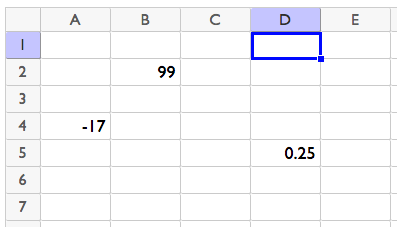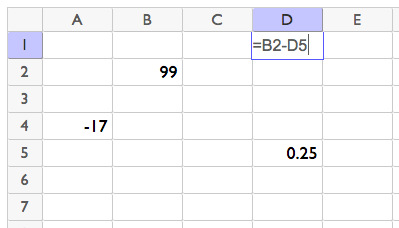Lesson 6
Mystery Computations
6.1: Make 24 (5 minutes)
Warm-up
In the next activity, students are asked to look for a rule that puts together some numbers to make a target number. This warm-up activates that sort of thinking.
Launch
Arrange students in groups of 2.
Ask each student to think of a whole number. (Make this more straightforward by limiting the choices to single-digit numbers, more challenging by limiting to 0–20 or 0–100, or really challenging by placing no restrictions on the numbers.) Select four students at random to share their number, and display these four numbers for all to see.
Student Facing
Your teacher will give you 4 numbers. Use these numbers, along with mathematical operations like addition and multiplication, to make 24.
Student Response
For access, consult one of our IM Certified Partners.
Activity Synthesis
Ask students to share their expression with a partner, so that their partner can verify that their expression is equal to 24. Then, select a few students to share their expression with the whole class and record these for all to see. How many different ways did the class find to make 24?
6.2: Mystery Operations (10 minutes)
Optional activity
In this activity, students experiment with an applet in which the value displayed in some cells depend on other cells. Monitor for students who notice interesting things.
Instead of writing down responses to the questions, it would make sense for students to share their observations verbally with a partner.
Some students will probably notice that the answers are in the spreadsheet. For example if you click on cell B2, you can see the formula that was used to generate the number that appears in that cell. They should be encouraged to use the values of the other cells to verify what they notice. Ultimately, all students should be able to interpret the spreadsheet formula in the cell.
Launch
Ensure that students have access to the embedded applet and that they understand how to type entries into cells. Call their attention to the task statement, which instructs them to try different numbers in column A and conjecture about how the numbers in column B are calculated.
Monitor for students who try interesting things, are able to predict what will be in a cell in column B, or can explain how a cell in column B is calculated.
Supports accessibility for: Language; Social-emotional skills
Student Facing
Try different numbers in column A, and observe what happens in column B. (Do not change anything in column B.) Try different numbers and try to predict what will happen in column B.
- How is the number in cell B2 related to all or some of the numbers in cells A2, A3, A4, and A5?
- How is the number in cell B3 related to all or some of the numbers in cells A2, A3, A4, and A5?
- How is the number in cell B4 related to all or some of the numbers in cells A2, A3, A4, and A5?
- How is the number in cell B5 related to all or some of the numbers in cells A2, A3, A4, and A5?
Student Response
For access, consult one of our IM Certified Partners.
Student Facing
Are you ready for more?
Check your conjectures by entering different kinds of numbers in column A, for example: fractions, decimals, very large numbers.
Launch
Distribute internet-enabled devices, and give students instructions to navigate to this lesson in the digital version of the materials.
Ensure that students have access to the spreadsheet applet and that they understand how to type entries into cells. Call their attention to the task statement, which instructs them to try different numbers in column A and conjecture about how the numbers in column B are calculated.
Monitor for students who try interesting things, are able to predict what will be in a cell in column B, or can explain how a cell in column B is calculated.
Supports accessibility for: Language; Social-emotional skills
Student Facing
Navigate to this activity in the digital version of the materials or to ggbm.at/fjcybyqf.
Input different numbers in column A, and try to predict what will happen in column B. (Do not change anything in column B.)
- How is the number in cell B2 related to all or some of the numbers in cells A2, A3, A4, and A5?
- How is the number in cell B3 related to all or some of the numbers in cells A2, A3, A4, and A5?
- How is the number in cell B4 related to all or some of the numbers in cells A2, A3, A4, and A5?
- How is the number in cell B5 related to all or some of the numbers in cells A2, A3, A4, and A5?
Student Response
For access, consult one of our IM Certified Partners.
Student Facing
Are you ready for more?
Check your conjectures by entering different kinds of numbers in column A, for example: fractions, decimals, very large numbers.
Anticipated Misconceptions
Students may be confused about how the term “related” is being used in the task statement. Explain that students should be trying to figure out what calculations take place with the numbers in column A in order to get the numbers in column B. Students may have difficulty figuring out the relationships between the numbers in column A and the numbers in column B. Suggest they try different kinds of numbers in column A, like small whole numbers, 0, multiples of 10, or decimal values.
Activity Synthesis
After students have had a chance to experiment with the applet and make conjectures about how the cells in column B are calculated, invite them to compare their conjectures with a partner.
Before selecting students to share their conclusions, select students to share their predicted value for various cells in column B based on combinations of values in column A. For example, “What would be the value in cell B4 if column A has the values 2, 4, 5, and 9?” (20)
Select students who tried or noticed interesting things to share with the whole class.
The words “sum" and “product” appear in the formulas. Briefly ask students to recall the meaning of these words. Invite them to guess what using the : symbol in the cell formula does. For example, =Sum(A2:A5) calculates A2 + A3 + A4 + A5.
6.3: More Spreadsheets! (15 minutes)
Optional activity
The purpose of this activity is to improve student familiarity with writing spreadsheet formulas based on references to other cells. In this activity, students have an opportunity to write their own spreadsheet formula in a cell and trade with a partner to guess their formula.
Launch
Supports accessibility for: Memory; Organization
Student Facing
- Change the spreadsheet so that B2 contains =A2+A4. To edit the formula in B2, you may have to click it twice.
- Change the numbers in A2 through A5. Make sure that your new formula does what it's supposed to do by doing a mental calculation and checking the result in B2.
- Change the contents of B3 so that B3 does something different.
- Before trading with a partner, make sure your new formula is not visible by clicking in a different cell.
- Trade with your partner.
- Change the numbers in column A to try and figure out your partner’s new rule.
Student Response
For access, consult one of our IM Certified Partners.
Launch
Supports accessibility for: Memory; Organization
Student Facing
Navigate to this activity in the digital version of the materials or to ggbm.at/wu9t7kkd.
- Change the spreadsheet so that B2 contains =A2+A4. To edit the formula in B2, you may have to click it twice.
- Change the numbers in A2 through A5. Make sure that your new formula does what it is supposed to do by doing a mental calculation and checking the result in B2.
- Change the contents of B3 so that B3 does something different.
- Before trading with a partner, make sure your new formula is not visible by clicking in a different cell.
- Trade with your partner.
- Change the numbers in Column A to try and figure out your partner’s new rule.
Student Response
For access, consult one of our IM Certified Partners.
Anticipated Misconceptions
Students may have difficulty inputing a new formula in a cell. For example, students may forget to begin the formula with =. Ensure that students know how to input the symbols that represent each operation.
Activity Synthesis
Ask students to report on the work they did with their partner.
- “Which formulas were interesting to guess?”
- “Which formulas were difficult to guess? What made them difficult?”
- “Which formulas were easy to guess? What made them easy?”
Design Principle(s): Support sense-making
6.4: Cool-down - What Does This Do? (5 minutes)
Cool-Down
For access, consult one of our IM Certified Partners.
Student Lesson Summary
Student Facing
Spreadsheets are useful mathematical and statistical tools. Here is an example of a spreadsheet. Each cell in the spreadsheet can be named with its column and row. For example, cell B2 contains the value 99. Cell A4 contains the value -17. Cell D1 is selected.

It is possible for the value in a cell to depend on the value in other cells. Let's type the formula \(=B2-D5\) into cell D1.

When we press enter, D1 will display the result of subtracting the number in cell D5 from the number in cell B2.

If we type new numbers into B2 or D5, the number in D1 will automatically change.
